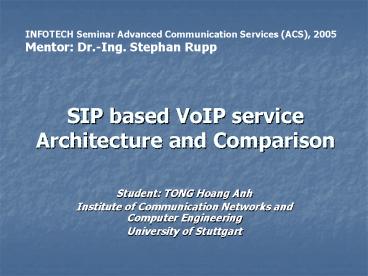SIP based VoIP service Architecture and Comparison PowerPoint PPT Presentation
1 / 22
Title: SIP based VoIP service Architecture and Comparison
1
SIP based VoIP service Architecture and Comparison
INFOTECH Seminar Advanced Communication Services
(ACS), 2005 Mentor Dr.-Ing. Stephan Rupp
- Student TONG Hoang Anh
- Institute of Communication Networks and Computer
Engineering - University of Stuttgart
2
General model for VoIP
3
General model for VoIP
4
Motivation
- Voice over IP expected to replace the Public
Switched Telephone Network (PSTN)
- Challenges
- provide new, attractive multimedia service
- control of advanced features(supplementary
services)
SIP and H323 are 2 approaches
5
Protocol Stack
6
Agenda
- SIP
- SIP architecture
- SIP messages
- Scenarios
- H323
- H323 architecture
- Scenarios
- Comparison and conclusion
7
SIP architecture
Accept REGISTER request from client
Forward message to next hop server
UACinitiate SIP request UASreturn SIP respond
Redirect caller to destination or other server
8
SIP messages
- INVITE invites a user to join a call.
- ACK confirms of the received response to an
INVITE. - BYE terminates the call between two of the
users on a call. - OPTIONS requests information on the
capabilities of a server. - CANCEL ends a pending request, but does not
end the call. - REGISTER informs a server the location of a
user.
9
Simplest peer-to-peer call setup
Bob
Alice
10
SIP operation in Proxy mode
11
SIP operation in Redirect mode
12
Agenda
- SIP
- SIP architecture
- SIP messages
- Scenarios
- H323
- H323 architecture
- Scenarios
- Comparison and conclusion
13
H323 architeture
Address Translation, Admissions Control,
Bandwidth Control, Zone Management
Enable conferencing MC multipoint call and
control signalling MP mixing, switching, and
processing of the audio, video, and data streams
H323 endpoint, originate and terminate H323
signalling and data stream (must support audio)
Data format translation, control signaling
translation, audio/video, codec translation, call
setup/termination functionality
14
H323 call establishment
15
H323 call control signalling
16
Media stream and Media control flow
17
H323 Call release
18
Agenda
- SIP
- SIP architecture
- SIP messages
- Scenarios
- H323
- H323 architecture
- Scenarios
- Comparison and conclusion
19
H323 vs SIP Comparison
Network components
Protocols running on terminal
20
Implementation comparison
21
Conclusion
- H323 is a comprehensive set of protocols, focus
on handling voice and multimedia calls including
supplementary services. - SIP is a generic transaction protocol for session
initiation, not limited to any specific media
services. - H.323 provides better functionality,
interoperability and interworking (with PSTN)
with respect to supplementary services. - SIP has its strengths for lightweight and
easy-implemented solutions with focus on flexible
session initiation. SIP provides better
mechanisms for controlling non-VoIP services. - Two standards are approaching each other.
- In the public VoIP services, SIP is currently the
dominent technology.
22
Thank you for your attention

